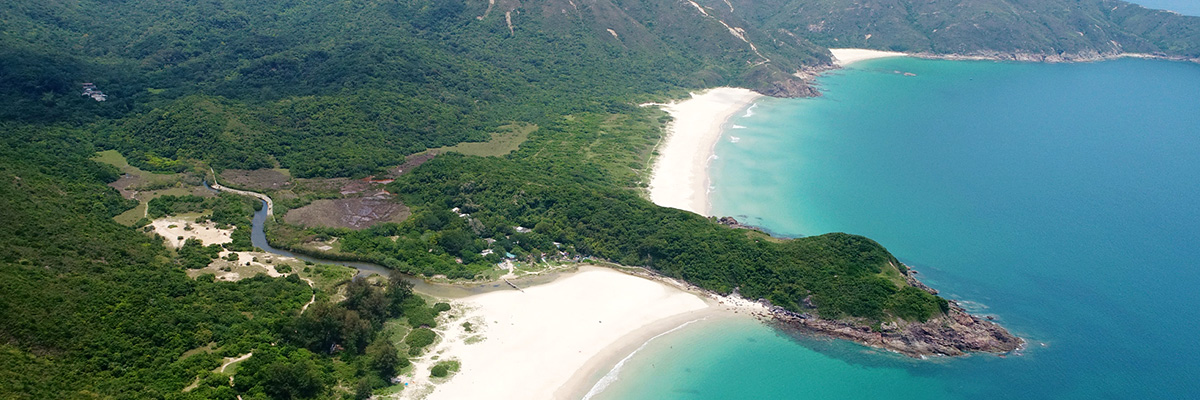

WORK OF THE COUNTRY AND MARINE PARKS BRANCH
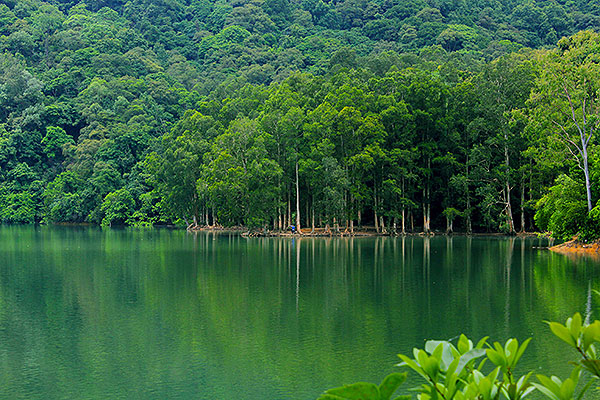
- To conserve the natural environment, local flora and fauna through the identification, designation and management of suitable areas as country parks, special areas, geopark, marine parks and marine reserves;
- To promote nature appreciation through publicity and educational activities and the provision of suitable facilities at country parks, marine parks and Hong Kong UNESCO Global Geopark; and
- To monitor important marine species such as the Chinese white dolphins, finless porpoises, coral communities and promote marine conservation.
COUNTRY AND MARINE PARKS
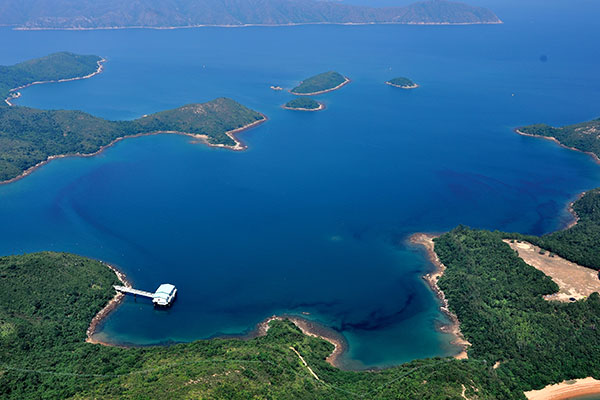
It has been 40 years since the first batch of country parks was established in 1977. To conserve the countryside, as at March 2018, 44 312 hectares (about 40% of Hong Kong's total land area) have been designated as country parks and special areas. The Department manages all 24 country parks and 22 special areas for conservation, recreation, education and tourism. Hiking trails, mountain bike trails, nature trails, barbecue and picnic sites, camp sites and visitor centres are provided in country parks, drawing some 13 million visitors in 2017-18.
The Department manages five marine parks and one marine reserve, covering 3
A map showing country parks, special areas, marine parks, marine reserve and the Hong Kong UNESCO Global Geopark is at Appendix 13.
COUNTRY PARK ENCLAVES
During the year, the Department had incorporated the enclaves at Fan Kei Tok and Sai Lau Kong into the Plover Cove Country Park, and the enclave at the site near Nam Shan into the Lantau South Country Park.
HILL FIRES
In 2017-18, 25 hill fires occurred over an area of 106 hectares with 850 trees damaged within or adjacent to country parks. More hill fires occurred in the Tai Lam Country Park and the area damaged was relatively large in the Lam Tsuen Country Park. Rehabilitation planting programme in areas damaged by hill fires and various fire prevention measures had been implemented.
TREE PLANTING
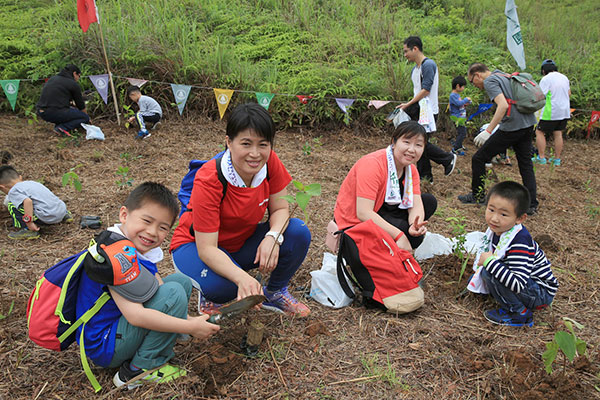
To enrich local plant diversity, the Department continued to produce and plant seedlings of native tree species. About 395
Seedlings are produced in the Tai Tong Nursery for tree planting in country parks. Located in the Tai Lam Country Park with an area of 9.5 hectares, the nursery produced over 395
COUNTRY PARK PLANTATION ENRICHMENT PROGRAMME
In the early years, exotic pioneer species were planted to prevent soil erosion and to quickly restore vegetation cover. This objective has been achieved with sustained efforts in the last few decades.
With time, existing plantations in country parks are facing problems such as aging, lack of growing space and slow natural regeneration of native plants, etc. In order to enhance the landscape and ecological value of these existing plantations, the Department launched the Country Park Plantation Enrichment Programme (PEP) in 2009 to enrich the overall value of country park plantations. During the dry season of 2017, about 12
In order to further promote the importance and benefits of the PEP in increasing the biodiversity and ecological value of plantations to wider sectors of the society, non-governmental organisations (NGOs) were invited to participate in the PEP in 2016. Apart from the three NGOs that have been participating since the first year, two more NGOs joined and committed to take up tree planting and tending works in selected suitable PEP sites identified by the Department in 2017-18, adding up to a total of five participating NGOs in these two years. The Department will continue to invite NGOs to participate in the PEP in coming years.
TREE MANAGEMENT
To improve tree management in Hong Kong for public safety, the Department has stepped up efforts in tree inspection, risk assessment and maintenance at the recreation sites of country parks and the country park areas adjacent to non-expressway public roads. Over 35
MOUNTAIN BIKE ACTIVITIES
Construction of re-routed mountain bike trails (MBT) at the Tai Lam Chung Reservoir Section and re-routed MBT at the Ho Pui Section have commenced this year with an aim of adding about one kilometre of MBT in the Tai Lam Country Park in 2018-19. Major improvements to specific sections of the Ho Pui MBT were also carried out to enhance bikers' safety, riding experience and the sustainability of the MBTs in accordance with the standards set by the International Mountain Bicycling Association. The re-routed sections are scheduled to open in September 2018.
HONG KONG UNESCO GLOBAL GEOPARK
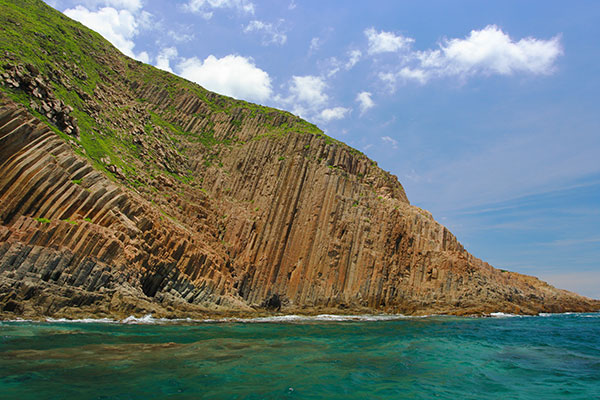
Located in the eastern part of Hong Kong and extended from the northeast New Territories to the Sai Kung area, the Hong Kong UNESCO Global Geopark (HKUGGp) is a single entity where sites and landscapes of international significance are holistically managed with the support of local communities and other geopark stakeholders. With the objectives of conservation, education and sustainable development, the geopark in Hong Kong protects Hong Kong's rich geological resources, many of which are of high research, tourism, educational and scenic value.
To ensure the HKUGGp benefits the environment, local people and the economy, the Department works closely with local communities and NGOs. There are three local geoheritage centres managed by local communities and a Volcano Discovery Centre (VDC) operated by a local community-led organisation. Served as a gateway to the HKUGGp, the VDC facilitated around 150
The HKUGGp strives to enhance the accessibility to geo-sites. Other than the kaito ferry service between Ma Liu Shui and Lai Chi Wo which commenced operation in January 2016, a new guided tour with shuttle bus services to the High Island Reservoir East Dam was also launched in July 2016. Both initiatives significantly enhanced the accessibility to the geo-sites.
To promote nature conservation and address the needs of the local communities in a sustainable way, the HKUGGp supports and collaborates with the local communities and stakeholders in the geopark through a series of capacity building and partnership projects. For example, local people have been engaged in the "Sustainable Lai Chi Wo Project", the Signature Project Scheme (North District) and the Chief Executive's Community Project at Lai Chi Wo.
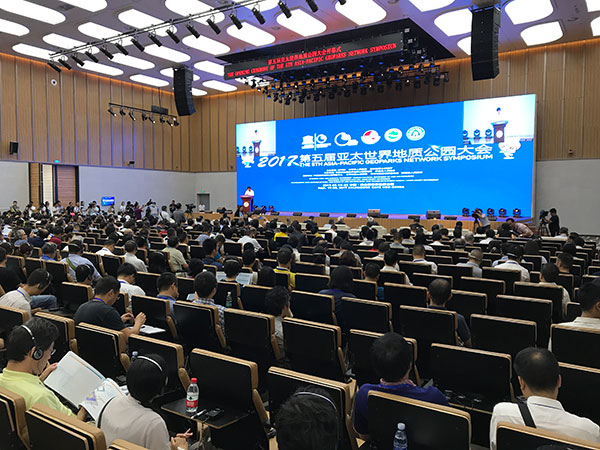
The HKUGGp is not only about co-operation with the local communities, but also about co-operating with other UNESCO Global Geoparks for knowledge exchange and experience sharing. On global networking, representatives of the HKUGGp attended the 5th Asia Pacific Geoparks Network Symposium at the Zhijindong Cave UNESCO Global Geopark in September 2017.
During the year, the HKUGGp School Programme continued to be a major science-popularisation initiative. During the summer holiday, the HKUGGp collaborated with local universities and offered training and work opportunities to local full-time undergraduate students at HKUGGp's visitor venues. In addition, the HKUGGp organised a series of talks to promote the geopark concept and to help students develop effective science transfer skills.
MANAGEMENT OF MARINE PARKS
To cope with the rising number of visitors to our marine parks, the Department has adopted a series of measures including strengthening patrols, assigning volunteers to disseminate codes for visitors, arranging guided activities and publishing educational materials. Law enforcement action was also stepped up to combat illegal activities.
PROPOSED MARINE PARKS
To enhance the conservation of the Lantau waters, the Department plans to designate more marine parks expeditiously, including the Southwest Lantau Marine Park, the South Lantau Marine Park, and the proposed marine park for the Hong Kong International Airport Three-Runway System Project. After the implementation of the above proposals, approximately 7
LAW ENFORCEMENT IN COUNTRY PARKS AND MARINE PARKS
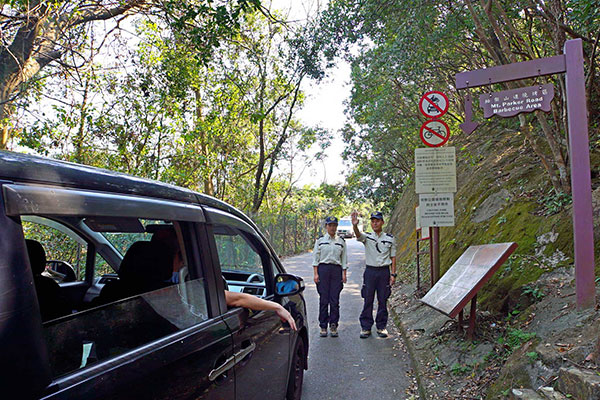
Park wardens patrol country parks and special areas on a regular basis to provide visitor services and to enforce the Country Parks Ordinance (Cap 208) and related legislation. In 2017-18, there were 931 concluded prosecution cases in relation to offences in the countryside. Relevant statistics are at Appendix 14. Park wardens and nature wardens also conduct frequent special operations in country parks, such as searching for illegal animal traps, visiting villages for the promotion of fire prevention, enforcing prohibition of feeding wild animals and assisting in search-and-rescue exercises. Regular joint operations with the Police are undertaken to combat crimes, such as illegal felling of Incense Trees.
In marine parks and marine reserve, wardens patrol on a daily basis, watching out for any illegal fishing activities. Close liaison is also maintained with the Marine Police and the Fisheries Authority of Shenzhen to combat illegal fishing by Mainland fishermen in marine parks. Wardens give advice or warnings to visitors and institute prosecutions when necessary. In 2017-18, 11 prosecutions were instituted against illegal fishing activities in marine parks.
COUNTRY PARKS EDUCATION PROGRAMME

The year 2017 is the 40th anniversary of the establishment of country parks. The Department launched a series of festivities on the theme "Country Parks Our Legacy" to celebrate. These events included Hiking and Planting Day, Excursion with Experts, Plantation Enrichment Project, Trail Maintenance Workshop, "Joy" us Hiking, "Trees are Good" Fun Day, Go Green Family Camping, Tai Tong Fun Carnival, roving exhibitions and seminars. They provided opportunities for the public to enjoy the fun of countryside and participate in conservation work.
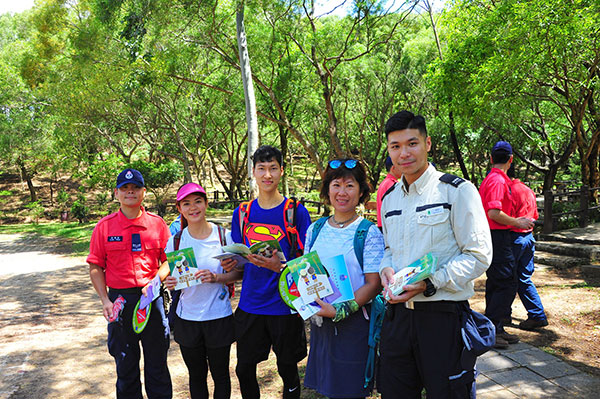
In 2017, the Department continued to carry out the Country Parks Education Programme "Nature in Touch" to strengthen the resources on nature education in country parks. The programme included a variety of public education activities such as operating a nature education centre and outdoor guided tours, workshops, stall games and photo exhibitions, as well as school educational activities such as country parks orienteering, visits to kindergartens, primary and secondary schools, and school eco-tours. The celebration programmes, together with other "Nature in Touch" activities, were well received by over 530
In addition, "Civil Aid Service Hiking Safety Promotion Day" and "Keep Fit Party Hiking Event" were held to introduce to the public the fun of hiking and the associated safety knowledge.
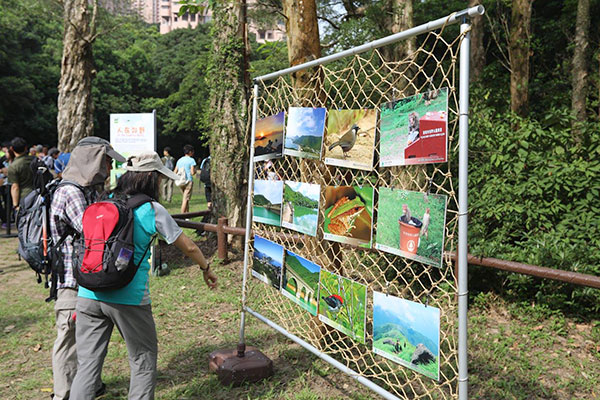
With a view to nurturing among the public an environmentally responsible habit of taking away waste after hiking in country parks, the Department launched a public education programme "Take Your Litter Home" in September 2015 with the support of green groups and hiking groups. The programme has yielded satisfactory results. By the end of 2017, all litter containers and recycle bins on hiking trails in country parks were removed. The Department has also stepped up publicity to further encourage the public to reduce waste at source and take their waste away after visiting the country parks.
During the year, 137 volunteers completed the basic volunteer training under the Country Park Volunteer Scheme. A total of 607 trained volunteers served 28
MARINE CONSERVATION EDUCATION
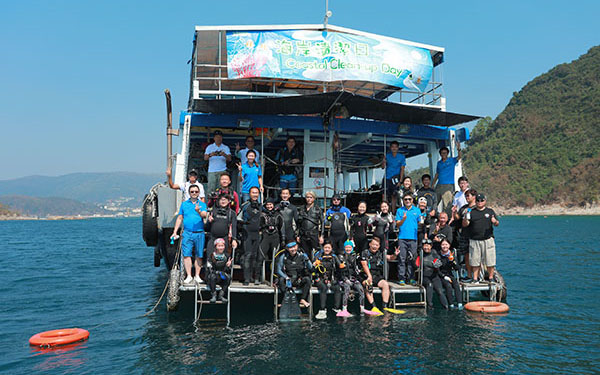
The Department organised a variety of marine conservation education activities targeting various sectors of the community. During the year, 122 public eco-tours, 15 public seminars, 31 beach clean-up activities, 3 competitions, 20 school lectures, 37 exhibitions and 10 other kinds of educational activities were held, benefiting over 112
During the year, 167 Marine Parks Ambassador participated in ten volunteer service, two activities and two training sessions to help promote marine conservation.
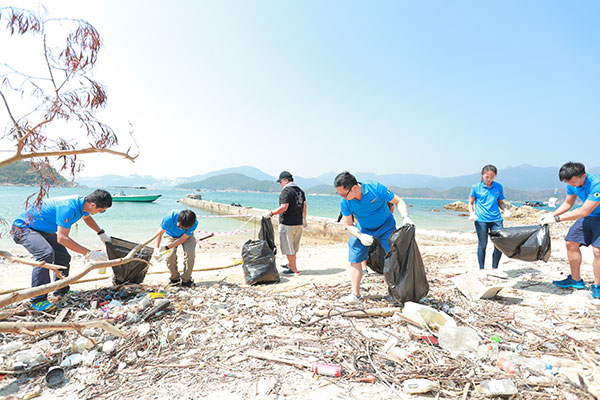
To promote the beauty of marine life and habitats as well as enhance public awareness of the importance in conservation of our marine environment, the Department and the Hong Kong Underwater Association co-organised the "Hong Kong Underwater Photo and Video Competition 2017" from May to October 2017. The competition was well-received with 436 entries submitted. The winning entries were exhibited in roving exhibitions at Olympic House, Taipo Mega Mall, Wonderful Worlds of Whampoa, Oi Tung Shopping Centre and the Hong Kong Convention and Exhibition Centre between October and December 2017.
The Department organised 13 dolphin field trips for 834 secondary school teachers and students in collaboration with the Ocean Park Conservation Foundation Hong Kong in 2017. The field trips provided opportunities for students to watch Chinese white dolphins and to learn more about marine conservation.
During the year, the Department organised a series of publicity and educational activities under the "Ting Kok Coastal Conservation Plan". These activities included the creation of a website, publication of pamphlets, provision of eco-tour, coastal clean-up, guided tour for experiencing fishermen culture, teacher workshop, photo competition, roving exhibition, and a nature appreciation programme "Tolo Whole Year Appreciation 2017".
The Department also launched a new education programme "Hong Kong Marine Classroom" during the year to consolidate all activities and services related to marine conservation and promote these activities to local schools under the same platform. In addition to provision of a booklet to all secondary and primary schools before each academic year, the Department also made use of the social media to enhance the effectiveness of promotion during the year.
MONITORING AND CONSERVATION OF MARINE SPECIES
Reef Check
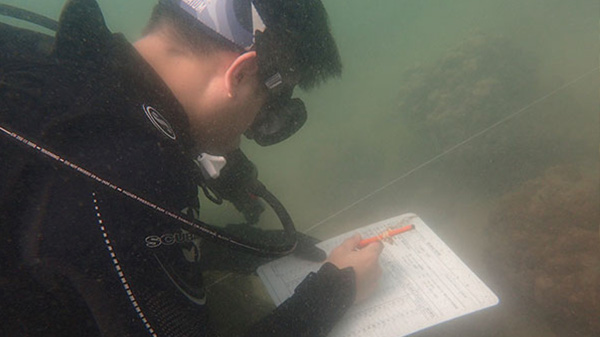
During the year, the Department continued to coordinate the annual Reef Check in collaboration with the Reef Check Foundation. 33 coral sites were surveyed with the assistance of over 760 volunteer divers. 20 of these coral sites recorded high coral cover (i.e. more than 50%) and the growth of corals at all sites was stable. Results of the Reef Check were publicised to enhance public awareness of the current status of our marine environment and to seek the public's cooperation in protecting our valuable marine resources. The findings also provided the Department with important information on the health status of corals so that appropriate actions could be taken to protect them.
Conservation of Corals
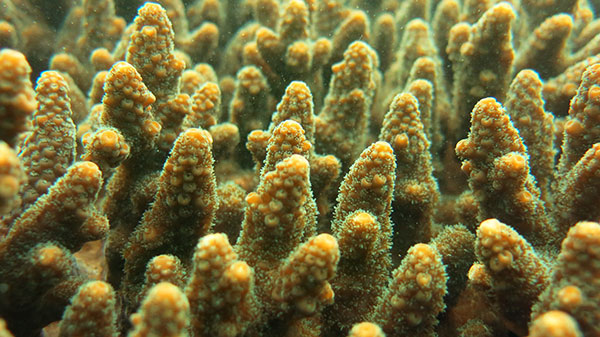
Besides designation of important coral habitats as marine parks, specially designed marker buoys were installed at Ung Kong Wan, Sharp Island West, Sharp Island East, South Ninepin, Shelter Island and Port Island, for better protection of corals from anchoring damage. Regular sea patrols and underwater ecological surveys are also conducted to monitor the effectiveness of the coral marker buoys in these areas, and the results to date are encouraging. There has been an overall increase in live coral cover in the marker buoy area. Damaged corals have shown signs of recovery.
Conservation of Marine Mammals
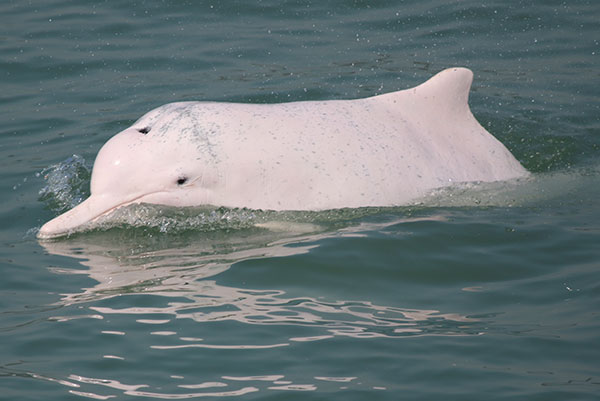
There are some 2
During the year, the Department continued to collaborate with the Ocean Park Conservation Foundation to investigate every reported dolphin stranding in Hong Kong. Tissue samples from the carcasses were collected for further studies. The Department continued to hold exhibitions and seminars as well as to distribute posters and leaflets to promote conservation of marine mammals, and publicise the code of conduct on dolphin watching and the dolphin stranding hotline. Through these efforts, the public gradually deepened their understanding of marine mammals.
Underwater Ecological Surveys
In 2011, the Department formed a diving team for underwater ecological survey comprising staff members experienced in SCUBA diving and underwater ecological survey. During the year, the diving team monitored coral communities and reef fishes.
Providing advice on development proposals
The Department provides comments and advice on development proposals and projects as well as environmental impact assessment studies to ensure that potential impacts of development projects on the marine environment and ecology would be adequately addressed, evaluated and minimised through effective mitigation.